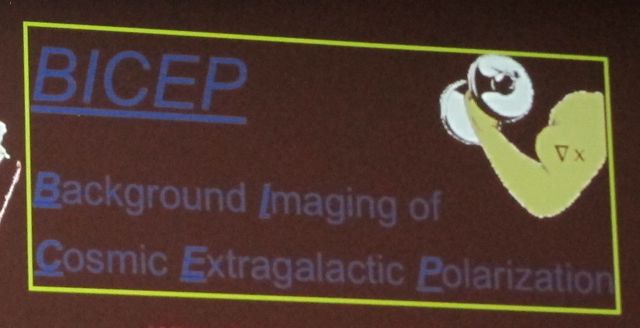Pamelia and I met up with astrophysicist Brian Keating three times, in three places, last year. We first chatted with him in his office at the University of California at San Diego, where we talked about his East Coast connections and what we do at The Naturalist's Notebook and he pulled out an inflatable model that helped explain the birth of the universe. A few weeks later, at his invitation (he wanted us to better understand his research), we hooked up with him at Dartmouth and MIT, where we sat in on lectures he gave to select groups of professors and graduate students. Little did we know at the time that Brian and a team of other top researchers were on the verge of making what could be one of the most significant discoveries in the history of cosmology. That discovery—a confirmation of the super-high-speed expansion of the newly born universe in the instant after the Big Bang ("cosmic inflation"), as evinced by the detection of a specifically polarized type of cosmic microwave background radiation emitted 13.8 billion years ago and gathered by a South Pole telescope called BICEP 2—was officially announced today.
BIG BANG DISCOVERY: PHYSICISTS HAIL COSMIC 'HOLY GRAIL' AS NOBEL PRIZE BECKONS, declared the Huffington Post. A NEW WINDOW ON THE BIG BANG HAS BEEN OPENED, added NPR. I will let another Naturalist's Notebook friend, Gary Robbins, who covers science and technology for the San Diego Union-Tribune and introduced us to Brian, explain the discovery in more detail. Here is a piece that Gary just posted under the headline SCIENTISTS SEE 'FINGERPRINT' OF BIG BANG:
http://www.utsandiego.com/news/2014/Mar/17/bigbang-universe-UCSD/?#article-copy
As Gary puts it, Brian "helped design, build and analyze data from the Background Imaging of Cosmic Extragalactic Polarization (BICEP2) telescope...[and] also created its predecessor, BICEP1." In other words, he was crucial to the discovery. As were many other people, of course—science nowadays is often a big-team game, and the squad involved in this project also included experts from Harvard, Stanford, Caltech, the University of Minnesota and NASA's Jet Propulsion Laboratory (which Pamelia and I will be visiting two weeks from now, by the way, though that's a story for another day).
Brian is just 42. In 2007 he received a U.S. Presidential Early Career Award for Scientists, the nation's highest honor for a young scientific researcher. He is part of an amazing group of physicists and astrophysicists whom Pamelia and I have been fortunate enough to meet in building our own team of collaborators for our art-and-science educational installations at The Naturalist's Notebook and our 13.8-Billion-Year HueStory of Our Life Project. That list includes, among others, Cal's Alex Filippenko, UC-Irvine's James Bullock, Dartmouth's Stephon Alexander and Miles Blencowe and the Harvard-Smithsonian Center for Astrophysics' Jonathan McDowell.
We think that people who work at the frontier of knowledge, like those just mentioned, deserve more recognition than they usually receive (which can be close to none in the mass media). They are the explorers of today. When we get a chance to celebrate one of them or all of them, we do. So huge congratulations, Brian. Onward and upward!
P.S. Here's a link to a CBS segment from a few years ago on Brian's work: http://www.cbsnews.com/videos/studying-space-from-antarctica/







